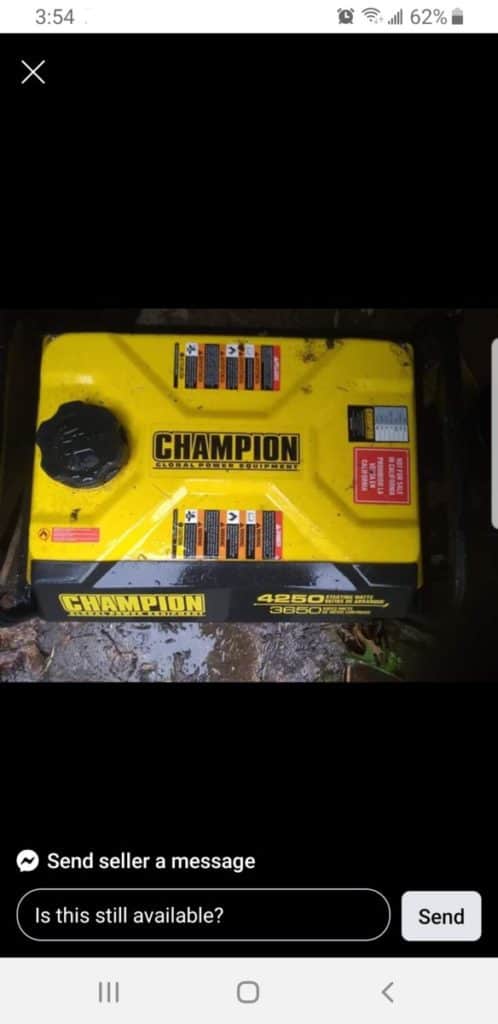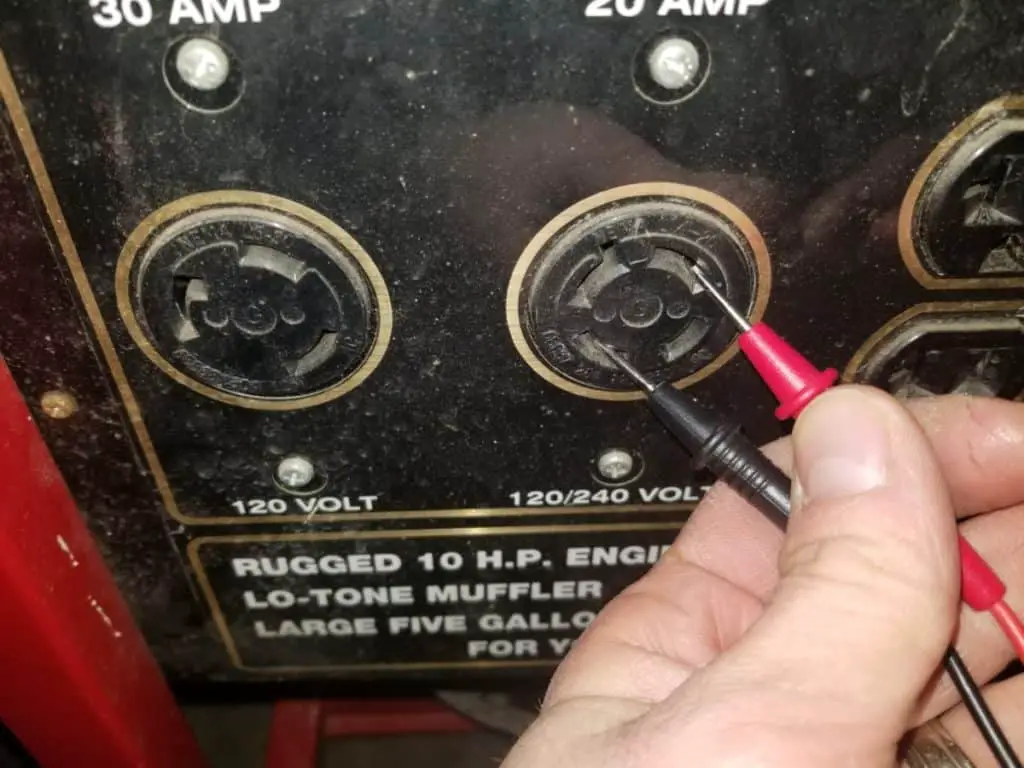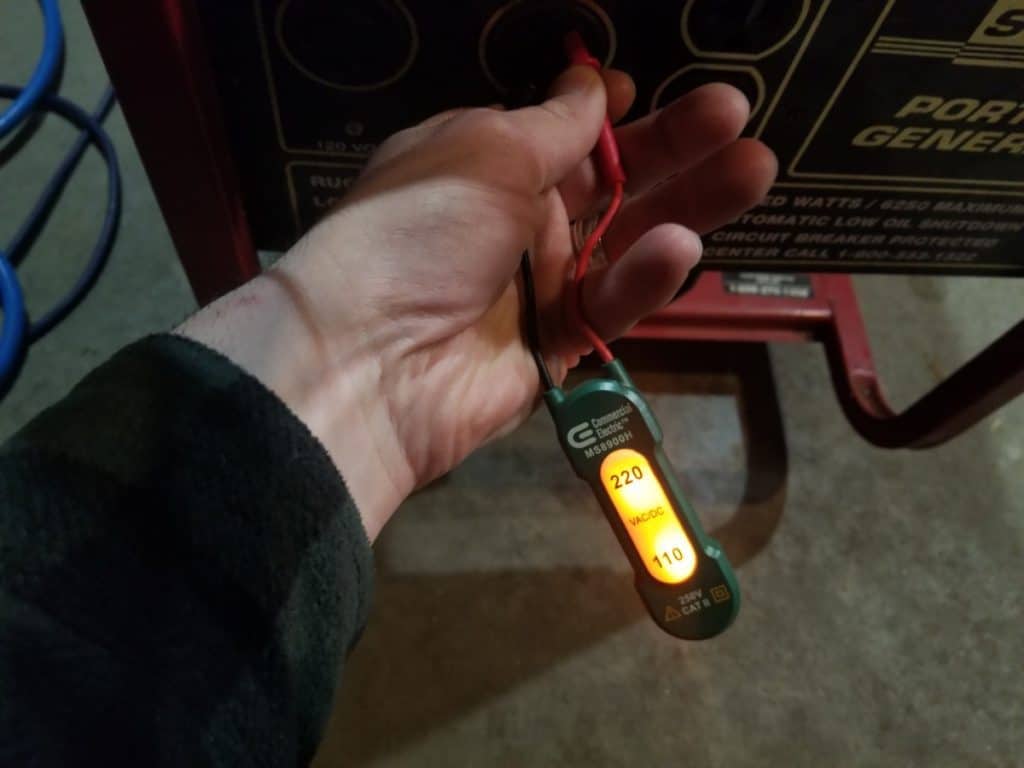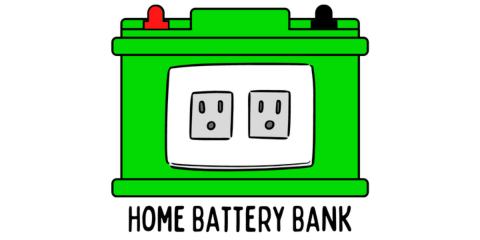I’ve been buying used generators and flipping them for quite a few years now to teach myself all about small engine repair. If you’re savvy and keep an eye out on social media, you can score some amazing deals on used generators.
Granted, I prefer to buy generators at rock bottom prices (or free) that the owner cannot get working, but I think I can help weigh in on this topic to give you a solid chance of scoring a gem!
This article will focus on purchasing a used generator that is in good, working order and not one that needs some fixing-up to work properly.
Hopefully, this will help you out and if you’re into doing some small, basic repairs, you might get an even better deal on your used generator and I can link you to some of my relevant articles to help you do some fast repairs.
What to Look for in the Advertisement for a Used Generator
Many of the used generators on the market are being listed on social media platforms like Facebook and on selling sites like Craigslist.
The first step in the process of buying a used generator is to filter out duds or be very cautious about certain things on the listing.
A picture paints a thousand words, so take note of where the generator is being photographed. Many times, people simply take a picture of where they store it. If you see it outside in the wet leaves or mud, or better yet, if you see it completely wet from being rained on — I recommend steering clear.
Maybe they just brought it out for a photo op, right? Look at the frame near the bottom and see if there is mud splatter.

Essentially, you want to weed out the generators that were stored outside. Those are the ones that will be more prone to rust issues, brittle fuel lines, damage to the electronics of the generator, rodent damage, and likely stale fuel.
I’m not saying that someone who stores their generator outside (even with a cover) doesn’t care about their generator, I’m just saying that they are more prone to issues down the road and you don’t want to be the recipient for them.
Also in the advertisement, you want to see as much information as possible. If it’s just a sale price with no description, I would steer clear. If someone cared for that generator and took pride in it, they are going to take the time to write at least a paragraph telling you something about it.
I generally like to see something along the lines of “We sold our cabin up north and this generator kept us powered when up there. I’ve already got a home generator so this isn’t needed anymore. Regular oil changes and only ran ethanol-free gas in it. It usually starts on the second pull.”
A description like that tells me that the owner regularly maintains it, knows how ethanol gasoline can corrode things and is intimate enough with the generator to know that it starts on the second pull. Plus, the reason for selling makes sense and you have a better chance of it not being a dud that’s just being dumped on someone else.
Do your Research on the Make/Model and Know What Used Generators Sell For Per Kilowatt
Once you find a decent listing, take a look at the make and model to see if the kilowatts are what you are needing. Then find what the unit is selling for brand new.
It really depends on the brand, but new generators usually sell around $100 to $125 per 1,000 watts. Champion generators sell for a bit more, and a Honda brand generator can go anywhere from $300 to $600 per kilowatt!
Then again, a Honda is the best of the best and they hold their value very well. So, if you can get a good deal on one — seriously consider taking it!
If I were buying a used generator, I would not be looking to pay more than 65%-75% of the price that it sells new. It’s called depreciation, and if your seller doesn’t understand that then I don’t know what to say. They are not going to get what they paid for it 5 years ago and after 175 hours of use.
If you come across a generator at a garage sale and you need to spitball a price — I would do $65 to $75 per kilowatt unless it’s a Honda. Then those numbers would be insulting to any seller who took care of their Honda. If you find a used Honda, you’re probably at least looking at $100 per kilowatt.
What to Ask the Owner Before You Meet
Before I meet someone, even when I’m buying duds to fix and flip, I generally ask the same questions in this order (with some niceties in there to soften it up):
“Are you firm at $(whatever price they listed)?”
Generally, people list a little high and expect to be talked down. If they are willing to come down a bit, then I will proceed with the following at some point:
“I’m definitely interested and if it runs well this is definitely what I’m looking for. Do you care if I stop by to inspect it and do a quick test run before I commit to the price?”
If your seller won’t let you inspect it or test it out, then you can end the transaction here. Hopefully, they won’t have a problem and you can proceed to the next phase.
Letting them know ahead of time that you are testing first before committing to the price is just common etiquette so that they aren’t offended if you find something wrong that will require repair and you want to drop the price a bit more.
Questions to Ask the Owner in Person about the Used Generator
When you get to the destination and are looking over the generator at a fist glance, now is the time to ask some probing questions but in a manner that is small talk.
I like to ask:
- How much oil does it take? (or, what weight of oil does it take?)
- What’s the best way to shut it off?
- What type of gas does it take?
- Any quirks? (or: Any tricks to starting it?)
- How often did you have to use it?
These questions all have their purpose, and you could answer all of them yourself if you simply did a quick review of the manufacturer’s specs of the generator before you showed up.
The point of the questions is to find out how the owner treated this generator — not how it was supposed to be treated.
If the owner can tell you or show you what oil was used (or how much), then that is an awesome sign that they kept up with the oil changes.
If the owner simply points out the “kill switch” on the generator as the means to shut it down without offering up any more information, then you can assume that they let the carburetor sit in storage with fuel in it. I ideally want an owner who shut the generator down by turning off the fuel valve. This lets the generator use up all the fuel in the fuel lines and empties the carburetor bowl which will prevent varnish buildup and from damaging the float needle.
If I ask, “what type of gas the generator takes”, and they respond, “regular”, then I am NOT going to be pleased. Sure, the generator can run on it, but you’re likely going to have compromised fuel lines and a gummed up carburetor if it was stored with that gasoline. This is especially true if the owner doesn’t mention using any fuel stabilizer like Stabil or SeaFoam which will prevent the fuel from turning to varnish.
If the owner tells you any quirks or tricks to starting, this isn’t necessarily a bad thing at all. It means they know their machine and having that knowledge is awesome and can point you in the right direction to hopefully fix something simple. This question is designed to give me a heads up on anything “wrong” and to let me know that this person knows their unit and has probably taken care of it even if they didn’t know how to fix something small.
Finally, when it comes down to how much they used it, I’m not only looking for an estimate on total hours but also on the frequency that they started it up when in storage. If they tell me that they always ran it for a half-hour every few months when not in use, I am going to be pleased. If they let it sit for a year or two in between startups, then you will have a higher likelihood of something being wrong with it.
According to americasgenerators.com a portable (not diesel) generator will have a lifespan of 2,000 -3,000 hours (83 – 125 full days) of use use before giving up the ghost. Keep this in mind when you go to purchase your used generator — especially if the model you’re purchasing has a meter on the side that tells you the total hours it has been used.
Tools to Take with You When Testing a Used Generator
I recommend taking the following tools that I show in the picture below.

You’re going to want a flashlight in case there are low light levels when inspecting and to look inside the gas tank. This also allows you to see everything below the gas tank (usually on top) which throws a shadow over everything.
A screwdriver with multiple bits for flathead and phillips — just in case. Some air filters are held on with screws and it might come in handy for that.
A multimeter or a simply 120-volt/240-volt voltmeter to check the outlets on the generator when it’s running. This will come in handy especially to check the 240-volt outlets since you’re not going to be carrying anything around that uses 240-volts. You won’t be able to see how it responds to being under load at 240-volts, but you’ll at least be able to confirm that the power is being supplied.
A circular saw to check test the 120-volt outlet and to see how the generator responds to 1,500 watts of electricity being demanded. You can pick something else, but I’d definitely do more than just a lamp and a lightbulb. If the generator is going to stall under a significant load, you want to know that ahead of time.
The last thing I like to bring is a ratchet and socket for the particular spark plug that this generator uses (you would learn this by checking the manufacturer’s specs when you first started researching it). I bring an extension as well since most are recessed.
What to Inspect on the Used Generator
After I’ve gained permission to do a routine inspection from the owner, I like to take a look at the air filter first and see if it is caked with debris, new, or moderately used. If it is caked with debris (or oil) then I know the generator has been running rich and that I likely have a fouled up spark plug as well.
If the air filter is clean it isn’t telling me anything except that I have a new air filter.
I also like to remove the spark plug and see how fouled up it is. If it is new, again, this doesn’t tell me anything about the condition the generator has been in. If it is used but only lightly dirty, then it probably has been running at a good air-to-fuel ratio. If it is black and has chunky carbon buildup, then it has been running too rich.
With the start switch off so the engine won’t start, see how easy it is to pull the recoil cord. If it doesn’t pull, then you’ve got a problem. It might be a simple fix (removing the sparkplug to relieve hydrolock) or something way more in-depth (shattered flywheel).
If the generator has a battery for starting (I still check the recoil cord) and you brought a multimeter with you, you can take a quick reading of the DC voltage of the battery. They are typically 12-volt batteries, so you would like to see 12.5-12.7 volts on the reading. If it’s lower than that, then you know they likely haven’t been keeping the battery charged when not in use or the battery is starting to go bad if they claim they have kept it charged.
Do the wheels work well if this generator is equipped with them? You don’t want to be dragging this thing around with a defective wheel.
How do the fuel lines look and wires? Is anything split, dry rot, loose?
Take a peek in the gas tank with the flashlight and shake the generator slightly to slosh the liquids around. Do you see blobs on the bottom that move around as the gasoline shakes? This would be water in your gas tank and a very likely sign that they used an ethanol blend of gasoline instead of ethanol-free gas. The ethanol in regular gasoline attracts water in the air and will lead to things getting gummed up.
Do the switches on the generator seem to “click” properly? If one doesn’t get into position with a definite “click” then you might have a broken one.
Is there any rust on the generator?
Finally, always check the oil. If it’s an amber color, then it is new. If it is black, then it is used. That’s not a big deal though since it can easily be changed. You want to see if the oil is filled properly which is generally to the top of the threads where the dipstick screws in.
If it is low, then the generator might have more wear and tear on the inside. If it is high and comes flooding out when you check it, then it has likely been burning oil when in use and building up unnecessary internal pressures.
Does the oil smell like gasoline? If so, you probably have a float needle in the carburetor that needs to be fixed. Is the oil dirty and has a sludge-like consistency? You might have a blown head gasket between the combustion chamber and any of the oil galleries or the pushrods. The exhaust blowing back into the crankcase from a ruptured head gasket will cause the oil to turn into sludge.
How to Test Run the Used Generator
Start it like normal. I generally turn the generator start switch off and pull gently on the recoil cord once. Then, I turn on the choke, make sure the fuel valve is open, and turn the start switch on. Give it a pull!
See how many pulls it takes to start. Five and under and I would be content. If you’re starting it with a battery and electric start, see how easily the starter turns over the engine.
When the engine starts, move the choke to half-choke for a little bit (depending on how cold it is outside) and then move to open-choke. Does it run fine when moved to open or does it want to stall?
Listen for any loud vibrations. If you hear loud metallic “pinging” that could be bad if it is coming from the engine itself. The last one I bought actually ended up coming from the recoil cord assembly being broken/loose and things were rattling around so that was an easy fix.
See if there is any smoke coming from the exhaust. Black would indicate that it is running rich and there is too much unburnt fuel exiting through the exhaust. White would mean that it is burning oil. I would be much more concerned with the latter since the first one is generally easier to fix and is generally a smaller problem.
Is the engine running smooth or is it surging?
You’ll always want to place the generator under load before purchasing it! I generally don’t care about this since I buy generators to fix and flip, but this is critical if you don’t want to be practicing your small engine repair skills and possibly ordering expensive parts.
I like to use the circular saw since it places a hefty demand on the generator within a fraction of a second. The amount is around 1.5kw (1,500 watts). Use common sense with this though. If your generator is a 1,000-watt generator, then using a circular saw is beyond its capacity. Try for something in the 600-700 watt range.
If the generator handles the circular saw without a problem and the engine still runs great while the saw is running, then I proceed to check the 240-volt outlets with a voltmeter since plugging anything into them is probably going to be impractical during a simple test run.


If everything checks out, then you’re safe to proceed. Just remember that used generators are always a gamble because you never know how they were treated by their owner and you don’t have the original warranty.
Deal Breakers on a Used Generator
These would be things that would turn me away from a purchase if I didn’t want to do any repairs (big or small) on the unit:
- A generator that won’t start at all by battery or recoil cord
- Excessively loud “pinging” coming from the engine
- Excessive white smoke (definitely so if there is smoke coming from the oil dipstick after a test run)
- Oil smelling like gas (Easy fix if you want to clean the carburetor — see bottom section)
- Engine runs but generator not providing power
- Generator keeps tripping when put under load
- Generator stalls when under load or when at idle
- Excessive revving up and down by the engine
- Excessive afterfiring (loud bangs) out the exhaust or backfire through the carburetor
- Any switches that aren’t working properly
Price Reducers or Things that Would Give me Pause on a Used Generator
Some of these are standalone reasons and some are something that would affect my decision as a cumulative effect. These are reasons that the owner may or may not have control over, and therefore asking them to come down further might be unfair since you are aware of what you’re getting into.
Still, you’ll want to make sure that you’re not going to have to replace 10 different things just to get in proper working order and will put you out $150.
- Generators that are new in box but priced at the MSRP (the original store price) — though it’s not used, you don’t have the original receipt to return it to the place of purchase if it’s a lemon
- How it was shut down — if simply turned off and allowed to have gas sitting in the fuel lines and carburetor, then you’re likely going to have at least a carburetor cleanup in front of you
- Rust — indicates that it probably had a lot of outdoor use or was stored outdoors
- Hoses and wires look cracked/dryrot — they’ll need to be replaced
- Generators with external fuel pumps (owner can’t control this, but they do tend to leak especially if it’s the original pump)
- A very dirty/fouled up sparkplug (not just black, but with the actual build-up of carbon debris) — indicates that the engine has been running rich for a long time and the combustion chamber is likely fouled up as well — higher risk of carbon flaking off and falling between the cylinder and piston and scoring the cylinder out which will lead to the engine burning oil
- Generators with a electric start that have a low voltage reading on the battery (it will probably have to be replaced
What to Do After You’ve Purchased the Used Generator
- Drain gasoline from the generator and replace with ethanol-free gasoline that has been treated with SeaFoam or the fuel stabilizer of your choice
- Drain oil and replace with the correct quantity and weight of oil that your manufacturer recommends
- Replace sparkplug with the manufacturer’s specified sparkplug
- Replace the air filter if it looks dirty
- Turn off the fuel valve and remove the carburetor bowl with a 10mm wrench to pour out any debris and check for varnish buildup
- Do a routine carburetor cleaning if you are up for the challenge (it’s easier than it sounds if you’ve never done it before and I have a link here that guides you through it or just skip to the bottom section of this article)
- Allow the generator to run for a few hours with a load on it to test it before you need to rely on it during an emergency
- Start and run your generator every couple months for at least 15 minutes with a load on it to keep the residual magnetism in the generator and the engine in proper working order
- Remember to shut off your generator by disconnecting all loads and turning the fuel valve off to allow the generator to burn the residual fuel in the lines and the carburetor bowl before stalls on its own
Remember, 75% of Problems with a Used Generator Originate from the Carburetor
Yes, I just made that statistic up, but from my experience, that seems to be the case. It doesn’t take a lot to clean up a carburetor to function like new and once you do a few you can knock one out in 30 minutes flat from start to finish. If it’s your first time it might take an hour.
But that hour can save you some big money on a generator!
You’d be surprised the deals you can find from people who don’t know how to clean a carburetor and would rather sell the generator than learn how to clean it. Carburetors that are dirty or clogged can cause a generator to stall, run rough, or simply not start at all.
If you are interested, I have a video that I made that shows a beginner how a carburetor works, where it’s located, and how to remove, clean and reassemble.
